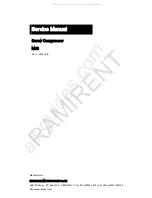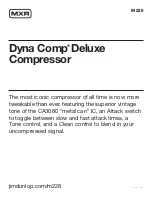
Page 7 of 23
⚠
CAUTION
AIR COMPRESSOR USE AND CARE
•
Do not force the air compressor. Products are safer and do a better job when used in the manner for
which they are designed. Plan your work and use the correct product for the job.
•
Check for damaged parts before each use. Carefully check that the product will operate properly and
perform its intended function. Replace damaged or worn parts immediately. Never operate the
product with a damaged part.
•
Do not use a product with a malfunctioning switch. Any power tool that cannot be controlled with the
power switch is dangerous and must be repaired by an authorized service representative before
using.
•
Disconnect the power/air supply from the product and place the switch in the locked or off position
before making any adjustments, changing accessories, or storing the tool. Such preventive safety
measures reduce the risk of starting the tool accidentally.
•
Store the product when it is not in use. Store it in a dry, secure place out of the reach of children.
Inspect the tool for good working condition prior to storage and before re-use.
•
Use only accessories that are recommended by the manufacturer for use with your product.
Accessories that may be suitable for one product may create a risk of injury when used with another
tool. Never use an accessory that has a lower operating speed or operating pressure than the tool
itself.
•
Keep guards in place and in working order. Never operate the product without the guards in place.
•
Do not leave the tool running unattended.
•
Drain the moisture from the tank on a daily basis. A clean, dry tank will help prevent corrosion.
•
Pull the pressure relief valve ring daily to ensure that the valve is functioning properly, and to clear
the valve of any possible obstructions.
•
To provide proper ventilation for cooling, the compressor must be kept a minimum of 12 inches (31
cm) from the nearest wall, in a well
–ventilated area.
•
Fasten the compressor down securely if transporting is necessary. Pressure must be released from
the tank before transporting.
•
Protect the air hose and electric cord from damage and puncture. Inspect them weekly for weak or
worn spots and replace if necessary.
•
To reduce the risk of electric shock, do not expose to rain. Store indoors.
•
Never operate the compressor if the power cord or plug are damaged. Take the equipment to the
nearest Authorized Service Center and a specialized technician will replace it.
Specific Operation Warnings
⚠
WARNING
•
Repairs attempted by unqualified personnel can result in serious injury or death by electrocution. Any
electrical wiring or repairs required on this product should be performed by authorized service center
personnel in accordance with national and local electrical codes.
•
Failure to provide adequate grounding to this product could result in serious injury or death from








































